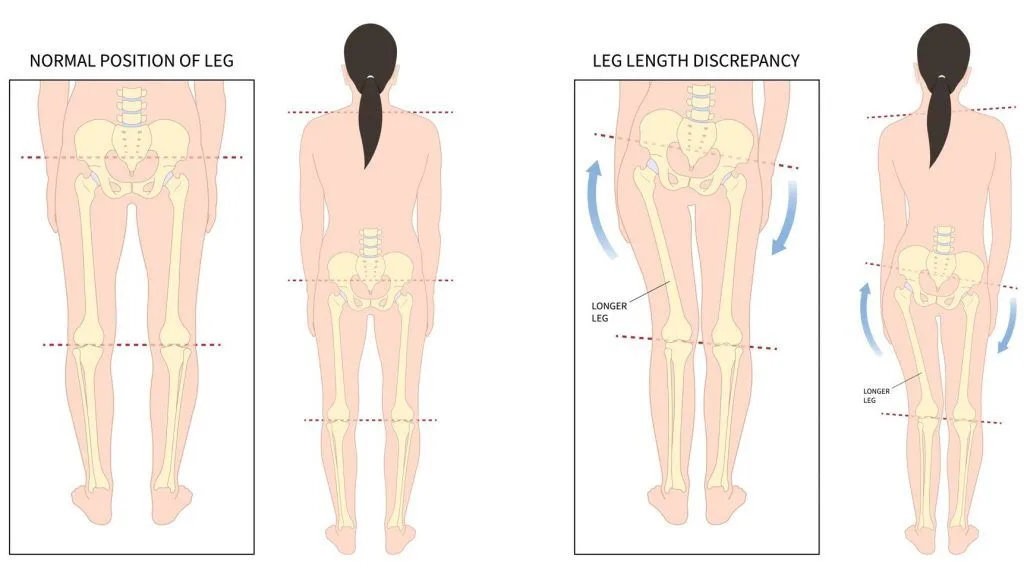Can a Chiropractor Help with Uneven Leg Length?
Introduction
In routine chiropractic practice, a common inquiry following the diagnosis of leg length discrepancy is whether it can be corrected. The answer to this question is not straightforward, as it depends on the specific type of leg length discrepancy present. This article aims to provide clarity and address any concerns you may have regarding this issue.
What is Leg Length Discrepancy?
Uneven leg length, or leg length discrepancy (LLD), is a condition where one leg is shorter than the other. This discrepancy can lead to various health issues, including posture imbalances, gait abnormalities, and chronic pain, particularly in the lower back, hips, and knees. Chiropractors, specializing in musculoskeletal health, can play a significant role in managing and treating LLD.
Understanding Leg Length Discrepancy
Types of Leg Length Discrepancy:
- Structural (Anatomical) LLD: This occurs when there is an actual difference in the length of the bones in the legs. It can be congenital or the result of injury or surgery.
- Functional LLD: This type results from muscle imbalances, joint dysfunction, or pelvic misalignment, where the bones are the same length, but one leg appears shorter due to these factors.
Chiropractic Assessment and Treatment
Assessment: A chiropractor begins with a thorough assessment to determine whether the LLD is structural or functional. This may include:
- Physical Examination: Assessing posture, gait, and alignment.
- Imaging: X-rays or other imaging techniques to measure leg length and identify structural issues.
- Leg Length Measurement: Techniques such as the Allis test or Galeazzi test to determine the extent of the discrepancy.
Treatment: Chiropractors can address LLD through various methods:
- Spinal Adjustments: To correct misalignments of the spine or pelvis that contribute to functional LLD.
- Pelvic Adjustments: To realign the pelvis and reduce the apparent leg length discrepancy.
- Custom Orthotics: Shoe inserts to help level the leg length difference, especially in structural LLD.
- Muscle Strengthening and Stretching: Exercises to improve posture and alignment.
- Lifestyle Modifications: Advice on posture, ergonomics, and exercises to manage symptoms.
Impact of Leg Length Discrepancy on Health
Posture Imbalances: LLD can cause significant posture imbalances. The body compensates for a shorter leg by adjusting spinal and pelvic alignment, which may lead to a tilted pelvis and spinal curvature (scoliosis). Over time, these imbalances strain muscles, ligaments, and joints, leading to poor posture and musculoskeletal issues .
Gait Abnormalities: A discrepancy in leg length affects gait patterns. The shorter leg often bears more weight, leading to uneven strides and increased stress on the muscles and joints. This altered gait can result in inefficient walking, increased energy expenditure, and higher risk of conditions such as shin splints .
Chronic Pain:
- Lower Back Pain: Common due to uneven weight distribution and altered spinal alignment. The shorter leg side may experience increased strain, leading to chronic lower back pain .
- Hip Pain: Pelvic tilting associated with LLD can cause uneven loading of the hip joints, leading to hip pain and conditions such as osteoarthritis .
- Knee Pain: The altered gait from LLD places extra stress on the knee joints, which can cause pain and conditions like patellofemoral pain syndrome .
Side-Specific Issues:
- Shorter Leg Side: Often bears more weight, leading to increased stress and pain in the lower back, hip, and knee on that side.
- Longer Leg Side: May experience broader compensatory issues due to pelvic tilting and spinal misalignment .
Prevalence and Threshold: Leg length discrepancy is common, affecting about 70% of the population, though most discrepancies are less than 1 cm (10 mm). Discrepancies greater than 10 mm are more likely to cause noticeable symptoms and health issues. Smaller discrepancies often do not result in significant health problems, while larger ones tend to have more pronounced effects .
Conclusion
Chiropractors can effectively address uneven leg length, particularly when it involves functional issues. Through a combination of spinal and pelvic adjustments, custom orthotics, and targeted exercises, chiropractic care can help alleviate symptoms, improve posture, and enhance overall function. For structural LLD, while chiropractic care alone may not completely correct the discrepancy, it can significantly reduce associated symptoms and improve quality of life.

